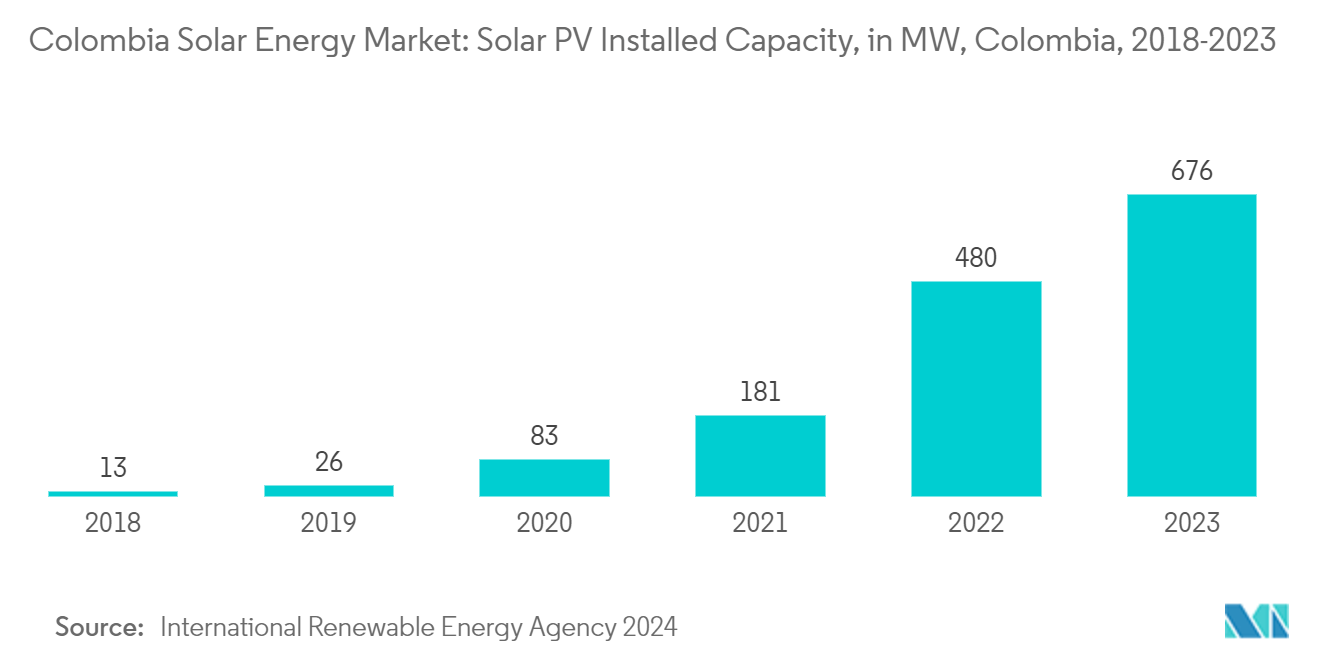Market Trends of Colombia Solar Energy Industry
Solar Photovoltaic is Expected to Dominate the Market
- The cost of solar PV modules has decreased rapidly over the years, making them increasingly affordable and cost-competitive compared to other energy sources. This cost reduction is primarily due to advancements in manufacturing processes, economies of scale, and increased efficiency of solar panels.
- Solar PV systems are highly scalable and can be deployed in various sizes, from small residential installations to large-scale solar farms. This flexibility makes solar PV suitable for various applications and enables it to meet diverse energy demands.
- Moreover, solar energy is abundant, particularly in countries like Colombia, which receives ample sunlight yearly. This availability of solar radiation makes solar PV a reliable and predictable energy source, offering a stable and consistent power supply.
- The solar PV installed capacity in the country has increased significantly in recent years. According to the International Renewable Energy Agency 2024, the installed solar PV capacity grew by more than twofold. The installed solar PV capacity in Colombia reached 676 MW in 2023.
- Moreover, in January 2023, Ecopetrol and Total Eren collaborated to develop a solar photovoltaic farm in Colombia. The Rubiales solar facility is expected to have a capacity of 100 MWp and will be built in the municipality of Puerto Gaitan in Colombia’s Meta province. Total Eren will hold a 51% stake in the Rubiales project, with Ecopetrol owning the remaining 49%.
- Furthermore, in February 2024, Enel Colombia announced that it inaugurated the 187 MW La Loma solar farm in the Colombian department of Cesar. The USD 126 million (EUR 116.9 million) project installed over 400,000 solar panels, enabling the plant to generate around 420 GWh of electricity per year.
- Therefore, due to the aforementioned factors, the solar PV segment is expected to dominate the Colombian solar energy market during the forecast period.

Government Initiatives are Expected to Drive the Market
- Governments play a crucial role in creating a favorable regulatory environment for the solar energy market. They establish clear guidelines and streamline project approvals, permits, and grid interconnection processes. By reducing bureaucratic barriers and simplifying procedures, governments facilitate the development of solar projects, attract investments, and drive market growth.
- Governments worldwide, including Colombia, have set ambitious renewable energy targets to combat climate change and reduce greenhouse gas emissions. These targets often include specific goals for solar energy deployment. To achieve these targets, governments introduce supportive policies and incentives to encourage the adoption of solar energy, such as feed-in tariffs, tax credits, and grants.
- Colombia and eight other Latin American countries are actively pursuing a regional target of achieving 70% renewable energy usage by 2030. As part of this collective effort, Colombia has set a goal to contribute 4 GW of renewable energy to its overall energy mix, thus supporting the regional objective for 2030. The majority share of renewable energy is expected to come through solar energy resources due to the high solar energy potential of the country, as it is located near the equator.
- Recently, hydropower has been the dominant source in Colombia's energy generation mix, accounting for over 70% of the total share. Additionally, the country has a significant proportion of gas power generation, representing approximately 11% of the overall energy mix. While Colombia has well-developed hydropower technology, the government recognizes the reliability challenges associated with this source due to factors like droughts and extreme weather conditions resulting from climate change. Therefore, the government has increased its focus on renewable energy sources like solar and wind energy.
- For instance, in March 2023, Colombia's National Mining and Energy Planning Unit (UPME) disclosed its latest auction aimed at acquiring renewable energy. Through this procurement process, a total renewable energy capacity of 7.493 MW was allocated. This capacity comprises 5.774 MW, distributed among 147 solar projects.
- Additionally, governments recognize the importance of diversifying their energy mix to enhance energy security and reduce dependence on fossil fuel imports. As domestically available energy, solar energy reduces a country's reliance on imported energy sources. Governments promote solar energy to achieve greater energy security and independence, which drives the market by encouraging investments in solar projects.
- In February 2024, the Government of Colombia announced that it had awarded 4.4 GW of solar PV capacity, which accounted for 99% of all renewable generation capacity offered in its latest auction. Although the Reliability Charge auction was open to all renewables, almost all the capacity was awarded to new solar capacities, with 30 projects awarded and expected to be operational between December 2027 and November 2028.
- Therefore, according to the abovementioned points, government policies are expected to supplement the market growth during the forecast period.


